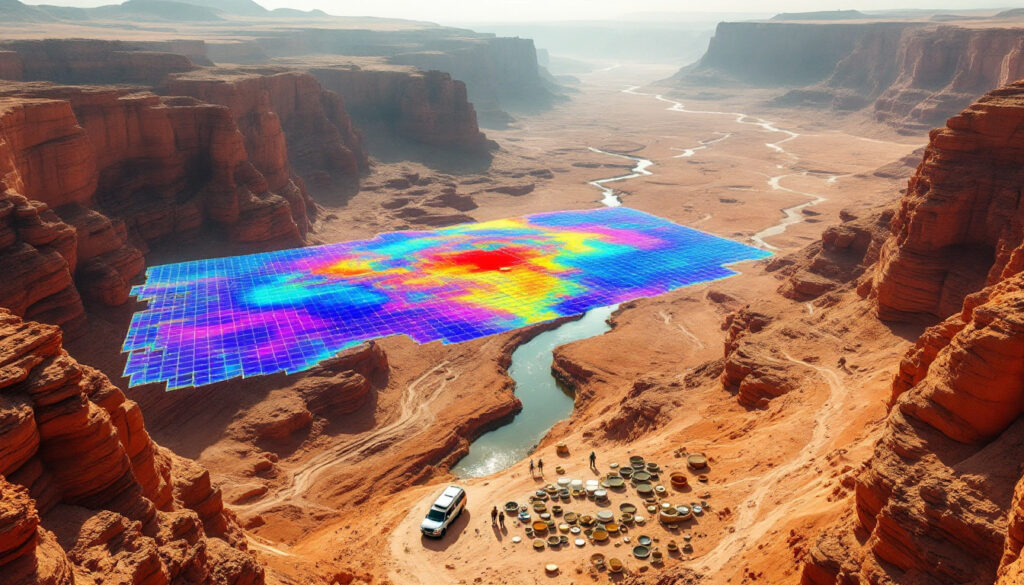What is the Arabian Shield Geochemical Survey Project?
The Arabian Shield Geochemical Survey represents one of the most ambitious geochemical mapping initiatives globally, spanning six years from 2021 to 2027. This high-resolution survey emerged from a strategic collaboration between the Saudi Geological Survey (SGS) as the client, the China Geological Survey (CGS) as the primary contractor, and technical partners including the Geological Survey of Finland and International Geosciences.
The project's primary objective is to produce comprehensive geochemical maps and atlases of unprecedented detail to stimulate mineral exploration and attract significant mining investment to Saudi Arabia. This initiative forms a critical component of the larger Regional Geological Survey Program, which integrates geological mapping, geophysical surveys, the National Geological Database, and the National Core Library.
Key Project Statistics
- Duration: 6 years (2021-2027)
- Sample collection: Over 86,000 sampling locations across the Arabian Shield
- Elements analyzed: 77 chemical elements (covering most of the periodic table)
- Current progress: Approximately 50,000 samples processed with data uploaded
- Maps produced: 1,550 geochemical maps available in both PDF and GIS formats
The scale of this initiative is unprecedented in the region. As noted by the Project Technical Partner Team Leader: "Saudi Arabia launched one of the world's largest geochemical and geochemistry service… This project is big. It spans six years from 2021 as you can see on the slide and it finishes in 2027."
How is the Geochemical Survey Conducted?
Sampling Design and Planning
The Arabian Shield Geochemical Survey employs a meticulously structured sampling methodology based on a hierarchical division of the study area:
- The entire survey area is divided into 50 quadrangles at 1:250,000 scale
- Each quadrangle is subdivided into 1:50,000 map sheets (25km × 25km)
- Each map sheet is further divided into 100 sub-squares (2.5km × 2.5km)
- One stream sediment sample is collected per sub-square
- Quality control includes 2% duplicate samples per map sheet
This systematic approach ensures comprehensive coverage across the varied terrain of the Arabian Shield, providing a sampling density significantly higher than most national-scale surveys worldwide.
Sample Collection Methodology
Field teams follow rigorous protocols to ensure sample integrity and representativeness:
- Samples are collected from active stream channels, primarily focusing on first to third order streams
- Collection occurs along 100-meter stretches of streams to ensure representativeness
- Special procedures have been developed for different landscapes including flat plains, sabkha (salt flats), harrat (basaltic volcanic areas), and nafood (sand dunes)
- A minimum of three sub-samples are collected at each site to minimize sampling variance
- Material is sieved to less than 2mm in accordance with international standards
- Samples are homogenized and quartered into two boxes for archive and analysis
- Complete photo documentation is maintained at all 86,000 sites
- Digital field data recording is conducted using the CGS master app for immediate data capture
Field Processing and Sample Handling
The project implements sophisticated sample management procedures:
- One sample split is archived at the Saudi Geological Survey for future reference
- The second split undergoes field processing before being sent to China for laboratory analysis
- Field processing is conducted at dedicated camps, such as the Medina facility
- Samples are double-sealed, QR-coded, and carefully tracked throughout the entire process
- Rigorous chain-of-custody protocols ensure sample integrity from collection to analysis
What Laboratory Analysis Methods Are Used?
Advanced Analytical Techniques
The analytical approach employed by the Arabian Shield survey sets a new standard for comprehensive elemental characterization:
- Analysis is conducted at the ISO-accredited Wuhan laboratory of China Geological Survey
- Ten different state-of-the-art laboratory methods are employed to achieve comprehensive elemental coverage
- Methods include Inductively Coupled Plasma Mass Spectrometry (ICP-MS) and X-Ray Fluorescence (XRF)
- The survey achieves uniquely low detection limits, including nanogram detection for gold and platinum group elements
- All detection limits are strategically set below crustal abundance levels to identify subtle anomalies
- A distinctive requirement mandates that 85-95% of samples must have measurable concentrations above detection limits
This analytical approach differentiates the Arabian Shield survey from many previous geochemical mapping initiatives by providing truly comprehensive elemental data rather than focusing solely on common or commercially significant elements.
Quality Assurance and Quality Control
The project implements one of the most rigorous QA/QC protocols in geochemical survey history:
- Both international reference materials and project-specific standards are used to ensure accuracy
- A balanced nested design incorporating normal and duplicate samples allows for variance analysis
- Each sample is analyzed twice in the laboratory to quantify analytical precision
- Analysis of variance (ANOVA) characterizes geological variability, sampling variance, and analytical variance
- Extensive quality control charts with over 76 repeated measurements are maintained
- Strict requirements for relative standard deviation ensure data quality meets or exceeds international standards
What Data Products Are Being Generated?
Geochemical Maps and Statistics
The project produces a diverse array of geochemical mapping products:
- Sample location maps documenting the spatial distribution of collection sites
- Classified point maps for each element showing concentration variations
- Contour maps with anomaly delineation highlighting spatial patterns
- Single-element geochemical maps for all 77 analyzed elements
- Statistical analysis for each element and quadrangle
- Rock unit-specific statistics providing geologically contextualized data
- An 85% threshold for anomaly identification
- Numbered and characterized anomalies for systematic exploration
- Normalized area of productivity calculated as a quantitative exploration indicator
These products provide unprecedented insight into the geology of ore deposits within the Arabian Shield, enabling more targeted and efficient mineral exploration.
Multi-Element Anomaly Maps
The project goes beyond single-element analysis to identify potential mineral deposits:
- Predefined sets of elements characteristic of different deposit types are analyzed collectively
- A fingerprinting approach helps identify potential mineralization based on element associations
- Anomalies are ranked based on mathematical criteria and mineral exploration considerations
- Verification against known mineral deposits validates the approach
- Identification of new potential exploration targets provides immediate value to the mining sector
This multi-element approach represents a significant advancement over traditional single-element geochemical surveys, allowing for more sophisticated interpretation of potential mineralization. Furthermore, the data generated supports effective mining investment strategies for companies interested in the region.
Heavy Mineral Concentrate Analysis
The project incorporates advanced mineralogical analysis to complement geochemical data:
- 10,000 sediment samples are selected for detailed mineralogical analysis
- Focus is placed on areas with multi-element anomalies to maximize efficiency
- Sampling targets sedimentological features where heavy minerals naturally accumulate
- A dedicated heavy mineral concentrate processing plant has been established in Medina
- Specialized equipment including spirals and shaking tables enables effective pre-concentration
This integration of geochemical and mineralogical data represents a best practice approach that is rarely implemented at this scale in national geochemical surveys. According to recent research on geochemical exploration techniques, such comprehensive approaches significantly improve discovery rates.
How Can Explorers Access and Use the Data?
Data Availability and Access
The project implements a progressive data release strategy to maximize value for the exploration community:
- Field database is available as Excel tables for easy access
- Chemical analysis database for approximately 50,000 samples has been uploaded
- 1,550 geochemical maps are available in both PDF and GIS formats
- Comprehensive metadata reports are provided to facilitate understanding of data generation and usage
- Data is accessible through the Saudi Geological Survey National Database Portal
- 56 elements are freely downloadable after registration
- 20 environmentally sensitive elements (including arsenic, mercury, thorium) are available upon specific request
This approach balances open data access with appropriate controls for environmentally sensitive information. The Saudi Geological Survey has also implemented digital transformation in mining to make data more accessible to stakeholders.
Applications for Mineral Exploration
The dataset offers numerous advantages for mineral exploration:
- High-resolution data allows identification of subtle anomalies that might be missed in larger-scale surveys
- Multi-element associations help identify potential deposit types based on geochemical signatures
- Heavy mineral concentrate data provides mineralogical confirmation of geochemical indicators
- Statistical analysis by rock type helps establish appropriate background levels for different geological contexts
- Normalized area of productivity provides numerical indicators for exploration prioritization
These features make the dataset an invaluable resource for both established mining companies and junior explorers seeking new opportunities in the Arabian Shield. For those new to the sector, a comprehensive mining investment guide can help navigate potential opportunities identified through the geochemical survey in the Arabian Shield.
What Makes This Survey Unique Compared to Global Standards?
Exceptional Features of the Arabian Shield Survey
Several factors distinguish this project from other major geochemical surveys worldwide:
- Analysis of 77 chemical elements (compared to 56 in European surveys)
- Sampling density of 2.5km × 2.5km (compared to 50km in other major national surveys)
- Exceptionally low detection limits set below crustal abundance for all elements
- Comprehensive quality control with extensive duplicate sampling
- Integration of chemical and mineralogical data provides multiple lines of evidence
- Adaptation to unique landscape challenges specific to Saudi Arabia
- Complete digitization with QR coding and comprehensive database management
- International collaboration bringing best practices from multiple countries
These distinctive elements position the Arabian Shield Geochemical Survey as a global benchmark for national-scale geochemical mapping. The Saudi Geological Survey's pioneering work has been highlighted by the Saudi Arabian Ministry of Industry and Mineral Resources as a cornerstone of the nation's mineral sector development strategy.
FAQ: Geochemical Survey in the Arabian Shield
How does the survey handle different geological landscapes in Saudi Arabia?
The project has developed specific sampling procedures for different landscapes including flat plains, sabkha (salt flats), harrat (basaltic volcanic areas), and nafood (sand dunes). In areas like harrat where there are no streams, regolith samples (rock fragments) are collected instead of sediments. This adaptive approach ensures comprehensive coverage despite the challenging and varied terrain of the Arabian Peninsula.
How does the survey address the challenge of windblown sand contamination?
When collecting samples, field teams systematically remove the surface cover to eliminate aeolian (windblown) contamination. Additional sieving is performed during field processing to remove fine aeolian material from the sediment samples. These procedures are critical in the desert environment of Saudi Arabia, where windblown sand can significantly impact sample integrity.
How are anomalies defined in the geochemical data?
The project uses an 85th percentile threshold for identifying anomalies. The high sampling density provides excellent spatial control for distinguishing true anomalies from background variations. Statistics are also calculated for different rock types to account for natural background variations in different geological units. This approach prevents the misidentification of naturally elevated concentrations as exploration targets and contributes to more accurate mining feasibility insights.
When will the complete dataset be available?
Currently, about 60% of the chemical data has been released through the Saudi Geological Survey. The remaining data is expected to be available within the next year (by 2025). This progressive data release strategy allows the exploration community to begin utilizing the information while the survey completion continues.
Want to Get Ahead of Major Mineral Discoveries?
Discovery Alert's proprietary Discovery IQ model provides real-time notifications for significant ASX mineral discoveries, turning complex data into actionable investment insights. Begin your 30-day free trial at Discovery Alert today and position yourself ahead of the market.




